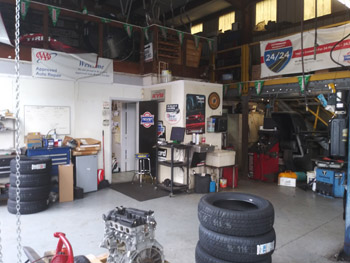All Categories
Featured
Brakes are arguably one of the most essential safety function of any car. Without trusted brakes, also one of the most effective vehicle can end up being a danger when driving. That's why regular brake assessments are a need to for guaranteeing your car stops when you require it to. Following a proper brake inspection routine can not just maintain you risk-free but likewise assist you avoid expensive repairs. Right here's a detailed guide on just how to properly inspect your brakes and what to keep an eye out for.
- The Relevance of Regular Brake Inspections. Brakes go through continual deterioration with every use, whether you're driving at broadband on the highway or cruising via city roads. Over time, brake pads, rotors, and various other components wear down, which can influence stopping efficiency. Without routine evaluations, you might not discover the gradual decrease in efficiency until it's far too late.
Regular brake evaluations enable you to capture issues early, making certain that your brakes stay responsive, dependable, and risk-free. Timely assessments can also save you money by resolving minor issues before they become costly repair services.
- Typical Indicators That Your Brakes Need Focus. While routine brake examinations are essential, there are some indication you can watch out for to understand when it's time to arrange a check-up:
Squeaking or Grinding Seems: Piercing squeaks or grinding noises when using the brakes are often indications that your brake pads are broken and need replacement. Resonance or Pulsation: If you really feel resonances in the steering wheel or the brake pedal, it might indicate distorted blades, which might require resurfacing or changing. Soft or Spongy Brake Pedal: If the brake pedal really feels uncommonly soft or squishy, there may be air in the brake lines or an issue with the master cyndrical tube. Pulling to One Side: If your auto draws away while braking, this can be brought on by uneven brake pad wear or an issue with the brake liquid. Enhanced Quiting Distance: If it takes longer to stop than normal, it may indicate that the brake pads are worn, the liquid is low, or the blades are damaged. If you notice any of these symptoms, it's ideal to have your brakes inspected right away.

- Trick Parts Checked Throughout Brake Inspections. During a brake assessment, a service technician will check a number of critical parts of the braking system to guarantee whatever is functioning appropriately. Right here are the key elements entailed:
Brake Pads: One of the most common reason for inadequate stopping efficiency is worn-out brake pads. Inspecting the thickness of the pads is a top priority during every inspection. Brake Rotors: Blades must be smooth and devoid of grooves or cracks. Any kind of considerable damages to the blades might result in jeopardized braking efficiency and irregular pad wear. Brake Fluid: Reduced or infected brake fluid can harm stopping performance. The service technician will inspect the fluid levels and high quality and change it if needed. Brake Lines and Tubes: Brake lines should be without leaks or fractures. Any kind of damages to the lines can result in loss of brake liquid, resulting in brake failing. Brake Calipers: The calipers use stress to the brake pads. They ought to be evaluated for indicators of wear or leakages to guarantee they are working correctly. Regularly checking these components assists maintain your brake system in peak condition, enabling you to quit your vehicle safely and effectively.
- Just how Frequently Should You Have Your Brakes Examined? The basic suggestion is to have your brakes examined at least yearly or every 12,000 miles, relying on your driving habits. Nonetheless, particular driving problems might require even more regular inspections:
Rush Hour: If you commonly drive in stop-and-go traffic, your brake pads will certainly put on down quicker. Mountain Driving: Driving on steep roads calls for more constant stopping, which can cause your brakes to use quicker. Towing or Hauling Heavy Plenties: If you on a regular basis bring heavy loads, your brakes will experience more tension and call for more frequent examinations. If you notice any one of the indication stated previously, do not wait on the following scheduled inspection-- have your brakes checked immediately.
- The Consequences of Neglecting Brake Inspections. Neglecting regular brake assessments can lead to severe effects. A failing brake system could result in lowered quiting power, which boosts your risk of accidents.
In the worst instance, driving with harmed brakes can result in finish brake failure, placing you and various other drivers in jeopardy. Regular brake inspections are a small financial investment that can save your life and stop costly repair services.
- Final Thought: Stay Safe with Routine Brake Inspections. Brakes are not something you desire to take opportunities with. A reliable stopping system is necessary for secure driving, and regular brake inspections are a straightforward method to guarantee that your automobile quits when you need it most. By staying on top of brake maintenance, watching for advising signs, and having your brakes inspected at the advised intervals, you'll shield both your automobile and your security.
Do not wait until your brakes begin to fail-- timetable routine brake inspections and keep your automobile in optimum condition for several years to find.
Latest Posts
Learn About Montclare Auto Repair’s Top Auto Repairs and Why Drivers Trust Them
Find Exceptional Vehicle Maintenance Solutions from Montclare Auto Repair – Keep Your Car Running Smoothly
Explore Budget-Friendly Auto Repairs with Montclare’s Limited-Time Service Specials
More
Latest Posts
Learn About Montclare Auto Repair’s Top Auto Repairs and Why Drivers Trust Them
Find Exceptional Vehicle Maintenance Solutions from Montclare Auto Repair – Keep Your Car Running Smoothly
Explore Budget-Friendly Auto Repairs with Montclare’s Limited-Time Service Specials
